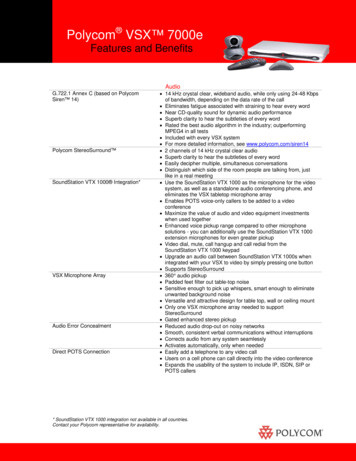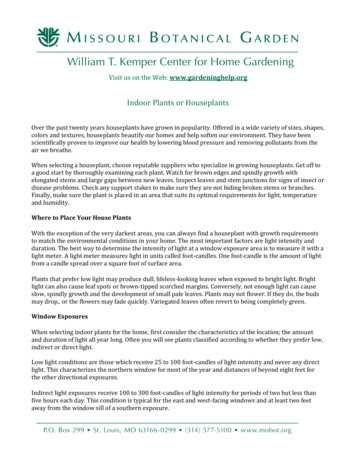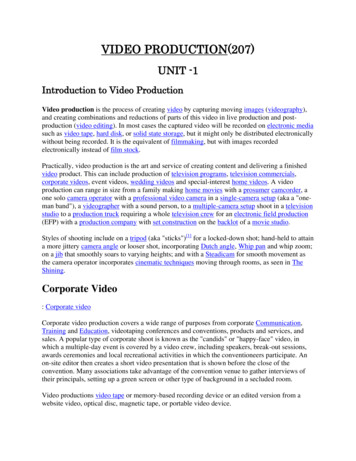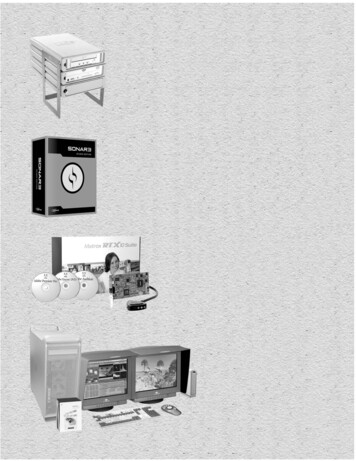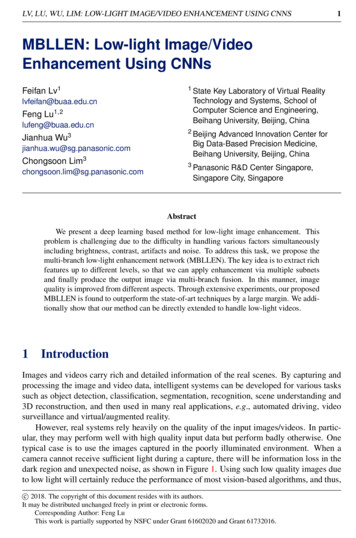
Transcription
LV, LU, WU, LIM: LOW-LIGHT IMAGE/VIDEO ENHANCEMENT USING CNNS1MBLLEN: Low-light Image/VideoEnhancement Using CNNsFeifan Lv11State Key Laboratory of Virtual RealityTechnology and Systems, School ofComputer Science and Engineering,Beihang University, Beijing, China2Beijing Advanced Innovation Center forBig Data-Based Precision Medicine,Beihang University, Beijing, China3Panasonic R&D Center Singapore,Singapore City, Singaporelvfeifan@buaa.edu.cnFeng Lu1, 2lufeng@buaa.edu.cnJianhua Wu3jianhua.wu@sg.panasonic.comChongsoon Lim3chongsoon.lim@sg.panasonic.comAbstractWe present a deep learning based method for low-light image enhancement. Thisproblem is challenging due to the difficulty in handling various factors simultaneouslyincluding brightness, contrast, artifacts and noise. To address this task, we propose themulti-branch low-light enhancement network (MBLLEN). The key idea is to extract richfeatures up to different levels, so that we can apply enhancement via multiple subnetsand finally produce the output image via multi-branch fusion. In this manner, imagequality is improved from different aspects. Through extensive experiments, our proposedMBLLEN is found to outperform the state-of-art techniques by a large margin. We additionally show that our method can be directly extended to handle low-light videos.1IntroductionImages and videos carry rich and detailed information of the real scenes. By capturing andprocessing the image and video data, intelligent systems can be developed for various taskssuch as object detection, classification, segmentation, recognition, scene understanding and3D reconstruction, and then used in many real applications, e.g., automated driving, videosurveillance and virtual/augmented reality.However, real systems rely heavily on the quality of the input images/videos. In particular, they may perform well with high quality input data but perform badly otherwise. Onetypical case is to use the images captured in the poorly illuminated environment. When acamera cannot receive sufficient light during a capture, there will be information loss in thedark region and unexpected noise, as shown in Figure 1. Using such low quality images dueto low light will certainly reduce the performance of most vision-based algorithms, and thus,c 2018. The copyright of this document resides with its authors.It may be distributed unchanged freely in print or electronic forms.Corresponding Author: Feng LuThis work is partially supported by NSFC under Grant 61602020 and Grant 61732016.
2LV, LU, WU, LIM: LOW-LIGHT IMAGE/VIDEO ENHANCEMENT USING CNNS(a) Input(e) Ying [43](b) Dong [9](f) BIMEF [41](c) NPE [37](g) Ours (MBLLEN)(d) LIME [14](h) Ground TruthFigure 1: The proposed MBLLEN can produce high quality images from low-light inputs. Italso performs well in suppressing the noise and aritifacts in dark regions.it is highly demanded by real applications to enhance the quality of the low-light imageswithout requiring additional and expensive hardware.Various researches have been done in the literature for low-light image enhancement.They typically focus on restoring the image brightness and contrast, and suppressing theunexpected visual effects like color distortion. Existing methods can be roughly divided intotwo categories, namely, the histogram equalization-based methods, and the Retinex theorybased methods. Algorithms in the former category optimize the pixel brightness based on theidea of histogram equalization, while methods in the latter category recover the illuminationmap of the scene and enhance different image regions accordingly.Although remarkable progress has been made, there is still a lot room to improve. Forinstance, existing methods tend to rely on certain assumptions about the pixel statistics orvisual mechanism, which, however, may not be applicable for certain real scenarios. Second,besides brightness/contrast optimization, other factors such as artifacts in the dark region andimage noise due to low-light capture should be handled more carefully. Finally, developingeffective techniques for low-light video enhancement requires additional efforts.In this paper, we propose a novel method for low-light image enhancement by takingthe success of the latest deep learning technology. At the core of our method is the proposedfully convolutional neural network, namely the multi-branch low-light enhancement network(MBLLEN). The MBLLEN consists of three types of modules, i.e., the feature extractionmodule (FEM), the enhancement module (EM) and the fusion module (FM). The idea is tolearn to 1) extract rich features up to different levels via FEM, 2) enhance the multi-levelfeatures respectively via EM and 3) obtain the final output by multi-branch fusion via FM.In this manner, the MBLLEN is able to improve the image quality from different aspects andaccomplish the low-light enhancement task to its full extent.Overall, our contributions are threefold. 1) We propose a novel method for low-lightimage enhancement based on the deep neural networks. It improves both the objective andsubjective image quality. 2) Our method also works well in terms of suppressing image noiseand artifacts in the low light regions. 3) Our method can be directly extended to process lowlight videos by using the temporal information. These properties make our method superiorto existing methods, and both quantitative and qualitative evaluations demonstrate that ourmethod outperforms the state-of-the-arts by a large margin.
LV, LU, WU, LIM: LOW-LIGHT IMAGE/VIDEO ENHANCEMENT USING CNNS23Related WorkThis section briefly overviews existing techniques for low-light image/video enhancement.Low-light image enhancement. Methods for low-light image enhancement can bemainly divided into two categories. The first category is built upon the well-known histogram equalization (HE) technique and also uses additional priors and constraints. In particular, BPDHE [15] tries to preserve image brightness dynamically; Arici et al. [2] propose toanalyze and penalize the unnatural visual effects for better visual quality; DHECI [29] introduces and uses the differential gray-level histogram; CVC [5] uses the interpixel contextualinformation; LDR [26] focuses on the layered difference representation of 2D histogram totry to enlarge the gray-level differences between adjacent pixels.The other category is based on the Retinex theory [22], which assumes that an image iscomposed of reflection and illumination. Typical methods, e.g., MSR [17] and SSR [18],try to recover and use the illumination map for low-light image enhancement. Recently,AMSR [24] proposes a weighting strategy based on SSR. NPE [37] balances the enhancement level and image naturalness to avoid over-enhancement. MF [11] processes the illumination map in a multi-scale fashion to improve the local contrast and maintain naturalness. SRIE [12] develops a weighted vibrational model for illumination map estimation.LIME [14] considers both the illumination map estimation and denoising. BIMEF [41, 42]proposes a dual-exposure fusion algorithm and Ying et al. [43] use the camera responsemodel for further enhancement. In general, conventional low-light enhancement methodsrely on certain statistical models and assumptions, which only partially explain the real worldscenes.Deep learning-based methods. Recently, deep learning has achieved great success inthe field of low-level image processing. Powerful tools such as end-to-end networks andGANs [13] have been employed by various applications, including image super resolution [4, 23], image denoising [31, 44] and image-to-image translation [16, 45]. Thereare also methods proposed for low-light image enhancement. LLNet [28] uses the deepautoencoder for low-light image denoising. However, it does not take advantage of recentdevelopments in deep learning. Other CNN-based methods like LLCNN [35] and [34] donot handle brightness/contrast enhancement and image denoising simultaneously.Low-light video enhancement. There are few researches for low-light video enhancement. Some of them [27, 36] also follow the Retinex theory, while others use the gammacorrection technique [19] or the similar framework for image de-haze [9, 30]. In order tosuppress artifacts, similar patches from adjacent frames can be used [21]. Although thesemethods have achieved certain progress in low-light video enhancement, they still sharesome limitations, e.g., temporal information has not been well utilized to avoid flickering.3MethodologyThe proposed method is introduced in this section with all the necessary details. Due to thecomplexity of the image content, it is often difficult for a simple network to achieve highquality image enhancement. Therefore, we design the MBLLEN in a multi-branch fashion.It decomposes the image enhancement problem into sub-problems related to different featurelevels, which can be solved respectively to produce the final output via multi-branch fusion.The input to the MBLLEN is a low-light color image and the output is an enhanced cleanimage of the same size. The overall network architecture and the data process flow is shownin Figure 2. The three modules, namely, FEM, EM and FM, are described later in detail.
4LV, LU, WU, LIM: LOW-LIGHT IMAGE/VIDEO ENHANCEMENT USING CNNSFEMCONV3 3CONV3 3W H 32CONV3 3EM3 3#n3 3FEMMELLENOutput16@5 5EMEMEMEMEM#1#2#n-1#nFM16@5 516@5 516@5 58@5 53@5 5DECNOVInput8@3 3CNOVCONVCONVFMFigure 2: The proposed network with feature extraction module (FEM), enhancement module (EM) and fusion module (FM). The output image is produced via feature fusion.3.1Network ArchitectureAs shown in Figure 2, the proposed MBLLEN consists of three types of modules: the featureextraction module (FEM), the enhancement module (EM) and the fusion module (FM).FEM. It is a single stream network with 10 convolutional layers, each of which useskernels of size 3 3, stride of 1 and ReLU nonlinearity, and there is no pooling operation.The input to the first layer is the low-light color image. The output of each layer is both theinput to the next layer and also the input to the corresponding subnet of EM.EM. It contains multiple sub-nets, whose number equals to the number of layers in FEM.The input to a sub-net is the output of a certain layer in FEM, and the output is a color imagewith the same size of the original low-light image. Each sub-net has a symmetric structure tofirst apply convolutions and then deconvolutions. The first convolutional layer uses 8 kernelsof size 3 3, stride 1 and ReLU nonlinearity. Then, there are three convolutional layers andthree deconvolutional layers, using kernel size 5 5, stride 1 and ReLU nonlinearity, withkernel numbers of 16, 16, 16, 16, 8 and 3 respectively. Note that all the sub-nets are trainedsimultaneously but individually without sharing any learnt parameters.FM. It accepts the outputs of all EM sub-nets to produce the finally enhanced image.We concatenate all the outputs from EM in the color channel dimension and use a 1 1convolution kernel to merge them. This equals to the weighted sum with learnable weights.Network for video. Our method can handle video enhancement after simple modification. 1) Let FEM perform 3D convolution instead of 2D convolution with 16 kernels of size3 3 3. The input of the first layer is the low-light color video which has 31 frames. Thefirst three dimensions of the output from each layer are sent to EM, and the rest dimensionsare used as the input to the next convolution. 2) EM is modified to perform 3D convolutions.3) FM uses original low-light video as additional input for fusion.3.2Loss FunctionIn order to improve the image quality both qualitatively and quantitatively, using commonerror metrics such as MSE and MAE is shown to be insufficient. Therefore, we propose anovel loss function by further considering the structure information, context information and
5LV, LU, WU, LIM: LOW-LIGHT IMAGE/VIDEO ENHANCEMENT USING CNNSLow-light?LossRegion LossStructural LossContent LossFEMEnhanced resultEMGround TruthFigure 3: Data flow for training. The proposed loss function consists of three parts.regional difference of the image, as shown in Figure 3. It is computed as:Loss LStr LV GG/i, j LRegion ,(1)where details of the structure loss, context loss and region loss are given below.Structure loss. This loss is designed to improve the visual quality of the output image. In particular, low-light capture usually causes structure distortion such as blur effectand artifacts, which is visually salient but cannot be well handled by MAE. Therefore, weintroduce the structure loss to measure the difference between the enhanced image and theground truth, so that to guide the learning process. In particular, we use the well-knownimage quality assessment algorithms SSIM [39] and MS-SSIM [38] to build our structureloss. A similar strategy has also been adopted in a recent method LLCNN [35].We use a simplified form of SSIM computed for a pixel p byLSSIM 1N2σxy C22µx µy C1· 2,22 µ 2 Cµσ1yx σy C2p img x (2)where µx and µy are pixel value averages, σx2 and σy2 are variances, σxy is covariance, and C1and C2 are constants to prevent the denominator to zero. Due to the page limit, the definitionof MS-SSIM can be checked in [38]. The value ranges of SSIM and MS-SSIM are ( 1, 1]and [0, 1], respectively. The final structure loss is defined as LStr LSSIM LMS SSIM .Context loss. Metrics such as MSE and SSIM only focus on low-level information inthe image, while it is also necessary to use some kind of higher-level information to improvethe visual quality. Therefore, we refer to the idea in SRGAN [23] and use similar strategiesto guide the training of the network. The basic idea is to employ a content extractor. Then,if the enhanced image and the ground truth are similar, their corresponding outputs from thecontent extractor should also be similar.A suitable content extractor can be a neural network trained on a large dataset. Becausethe VGG network [33] is shown to be well-structured and well-behaved, we choose the VGGnetwork as the content extractor in our method. In particular, we define the context loss basedon the output of the ReLU activation layers of the pre-trained VGG-19 network. To measurethe difference between the representations of the enhanced image and the ground truth, wecompute their sum of absolute differences. Finally, the context loss is defined as follows:WLV GG/i, j HCi, j i, j i, j1 kφi, j (E)x,y,z φi, j (G)x,y,z kWi, j Hi, jCi, j x 1y 1 z 1(3)where E and G are the enhanced image and ground truth, and Wi, j , Hi, j and Ci, j describe thedimensions of the respective feature maps within the VGG network. Besides, φi, j indicatesthe feature map obtained by j-th convolution layer in i-th block in the VGG-19 Network.
6LV, LU, WU, LIM: LOW-LIGHT IMAGE/VIDEO ENHANCEMENT USING CNNSRegion loss. The above loss functions take the image as a whole. However, for ourlow-light enhancement task, we need to pay more attention to those low-light regions. Asa result, we propose the region loss, which balances the degree of enhancement betweenlow-light and other regions in the image.In order to do so, we first propose a simple strategy to separate low-light regions fromother parts of the image. By conducting preliminary experiments, we find that choosing thetop 40% darkest pixels among all pixels gives a good approximation of the low-light regions.One can also propose more complex ways for dark region selection and in fact there are manyin the literature. Finally, the region loss is defined as follows:LRegion wL ·1mL nLnL mL1nH mH (kEL (i, j) GL (i, j)k) wH · mH nH (kEH (i, j) GH (i, j)k),i 1 j 1(4)i 1 j 1where EL and GL are the low-light regions of the enhanced image and ground truth, and EHand GH are the rest parts of the images. In our case, we suggest wL 4 and wH 1.3.3Implementation DetailsOur implementation is done with Keras [7] and Tensorflow [1]. The proposed MBLLEN canbe quickly converged after being trained for 5000 mini-batches on a Titan-X GPU with a setof 16925 images from the PASCAL VOC dataset [10]. We use mini-batches of 24 patchesof size 256 256 3. The input image values should be scaled to [0, 1].In terms of designing the context loss, we test each convolutional layer of VGG-19.From the fourth convolution block, the enhancement effect decreases slightly. On the otherhand, with deeper layers, the feature map size decreases, which increases the computationalefficiency. As a trade-off, we use the output of the fourth convolutional layer of the thirdblock of VGG as the context loss extraction layer.In the experiment, training is done using the ADAM optimizer [20] with a learning rateof α 0.002, β1 0.9, β2 0.999 and ε 10 8 . We also use the learning rate decaystrategy, which reduces the learning rate to 95% before the next epoch.4Experimental EvaluationThe proposed method is evaluated and compared with existing methods through extensiveexperiments. For comparison, we use the published codes of the existing methods.Overall, we have done four major sets of experiments as follows. 1) We compare ourmethod with a number of existing methods including those latest and most representativeones on the task of low-light image enhancement. 2) We show another set of comparisonson the task of low-light image enhancement in the presence of Poisson noise. 3) We showexperimental results using real-world low-light images. 4) We conduct further experimentson low-light video enhancement.4.1Dataset and MetricsCapturing real-world low-light images with ground truth is difficult. Therefore, followingthe previous research [28], we produce a large set of low-light images via synthesis based onthe PASCAL VOC images dataset [10] for this research.
LV, LU, WU, LIM: LOW-LIGHT IMAGE/VIDEO ENHANCEMENT USING CNNS7Low-light image synthesis. Low-light images differ from common images due to twomost salient features: low brightness and the presence of noise. For the former feature, weapply a random gamma adjustment to each channel of the common images to produce theγlow-light images, which is similar to [28]. This process can be expressed as Iout A Iin ,where A is a constant determined by the maximum pixel intensity in the image and γ obeysa uniform distribution U(2, 3.5). As for the noise, although many previous methods ignoreit, we still take it into account. In particular, we add Poisson noise with peak value 200 tothe low-light image. Finally, we select 16925 images in the VOC dataset to synthesize thetraining set, 56 images for the validation set, and 144 images for the test set.Low-light video synthesis. We chose e-Lab Video Data Set (e-VDS) [8] to synthesizelow-light videos. We cut the original videos into video clips (31 255 255 3) to build adataset of around 20000 samples, 95% of which form the training set and the rest for test.Performance metrics. To evaluate the performance of different methods from different aspects and in a more fair way, we use a variety of different metrics, including PSNR,SSIM [39], Average Brightness(AB) [6], Visual Information Fidelity(VIF) [32], Lightnessorder error(LOE) as suggested in [41] and TMQI [40]. Note that in the tables below, red,green and blue colors indicate the best, sub-optimal and third best results, respectively.4.2Low-light Image without Additional NoiseWe conduct experiments using the synthetic dataset. Results are compared between ourmethod and other 10 latest methods, as shown in Table 1. Our method outperforms all theother methods in all cases and is far ahead of the second (green) and third best (blue).InputSRIE [12]BPDHE [15]LIME [14]MF [11]Dong [9]NPE [37]DHECI [29]WAHE [2]Ying [43]BIMEF 1817.6419.6619.8026.56SSIM 89VIF 606.98648.29892.56675.15478.02TMQI 91AB 30.282.57-20.22-0.96Table 1: Comparison of low-light image (without additional noise) enhancement.Representative results are visually shown in Figure 4. By checking the details, it is clearthat our method achieves better visual effects, including good brightness/contrast and lessartifacts. It is highly encouraged to zoom in to compare the details.In order to emphasize our advantage in detail recovery besides the brightness recovery,we scale the image brightness of all methods according to the ground truth so that they havethe exactly correct maximum and minimum values. Then, we compare the results in Table 2.Due to space limit, we only select those best methods from Table 1. The results show thatour method still outperforms all other methods by a large margin.
8LV, LU, WU, LIM: LOW-LIGHT IMAGE/VIDEO ENHANCEMENT USING CNNSInputMF [11]LIME [14]Ying [43]BIMEF [41]OursGround TruthFigure 4: Comparison of low-light(no additional noise) images.WAHE [2]MF [11]DHECI [29]Ying [43]BIMEF [41]OursPSNR17.4318.6418.3419.9316.7526.65SSIM [39]0.650.670.680.730.710.89VIF 92.53674.53477.95TMQI [40]0.840.840.870.860.830.90AB [6]-30.70-22.74-2.092.22-34.44-1.30Table 2: Comparison of different methods after brightness scale according to ground truth.InputMF [11]LIME [14]Ying [43]BIMEF [41]OursGround TruthFigure 5: Enhancement comparison of low-light(with additional Poisson noise) images.
9LV, LU, WU, LIM: LOW-LIGHT IMAGE/VIDEO ENHANCEMENT USING CNNS4.3Low-light Image with Additional Poisson NoiseWe test our method on low-light images with additional Poisson noise. For comparison, wechoose the best comparison methods from Table 1, and use them along with the IVST [3]denoising method to produce the final comparison results. A variety of quality metrics areused for evaluation in the cases of original output (left number) and scaled output (rightnumber) as in the last experiments, as shown in Table 3.WAHE [2]MF [11]DHECI [29]Ying [43]BIMEF /19.6920.27/17.5625.97/26.39SSIM .87/0.87VIF 928.13/927.83725.72/725.61573.14/573.14TMQI .90/0.89AB [6]-26.41/-30.04-13.77/-16.883.75/ 0.1610.99/ 6.99-11.58/-31.131.45/ -1.57Table 3: Comparison on low-light (with additional Poisson noise) images enhancement. Asdescribed earlier, the numbers on the right indicate the brightness-scaled results.In Table 3, our method almost achieves all the best results under all quality metrics. Theonly case it ranks second is on the brightness-scaled result under the AB metrics. However,note that for brightness-scaling, we need to provide all the methods with the ground truthbrightness, and such results are just for reference but not for a fair comparison. Visualdemonstration is given in Figure 5.4.4Real-world ImageBesides the above synthetic dataset, our method also performs well on the natural low-lightimages and outperforms existing ones. Due to page limit, comparison on one representativeexample is shown in figure 6, along with additional low-light image enhancement results byour method. More results and comparisons, including those for previous sections, are included in the supplementary files, which fully demonstrate the effectiveness of our method.InputDong [9] AMSR [25] NPE [37]LIME [14] Ying [43] BIMEF [41]OursFigure 6: Some real-world results. Image in the first row is captured in a railway station.The rest images are from the Vassilios Vonikakis dataset downloaded from the Internet.
104.5LV, LU, WU, LIM: LOW-LIGHT IMAGE/VIDEO ENHANCEMENT USING CNNSLow-light VideoExisting methods typically process videos in a frame-by-frame manner. On the other hand,our modified method can process low light videos more efficiently via 3D convolution.PSNRSSIM [39]AB(Var) [6]LIME [14]14.260.590.015Ying [43]22.360.780.025BIMEF 0.830.006Table 4: Quantitative evaluation on low-light video enhancements.Comparison of our MBLLEN, its video version (MBLLVEN) and three other methodsare shown in Table 4. We also introduce the AB(var) metric to measure the difference of theaverage brightness variance between the enhanced video and the ground truth. This metricreflects whether the video has unexpected brightness changes or flickers, and the proposedMBLLVEN achieves the best performance in preserving the inter-frame consistency. Theenhanced videos are provided in the supplementary files for intuitive comparison.5ConclusionThis paper proposes a novel CNN-based method for low-light enhancement. Existing methods usually rely on certain assumptions and often ignore additional factors such as imagenoise. To solve those challenges, we aim at training a powerful and flexible network to address this task more effectively. Our network consists of three modules, namely the FEM,EM and FM. It is designed to be able to extract rich features from different layers in FEM,and enhance them via different sub-nets in EM. By fusing the multi-branch outputs via FM,it produces high quality results and outperforms the state-of-the-arts by a large margin. Thenetwork can also be modified to handle low-light videos effectively.References[1] Martín Abadi, Ashish Agarwal, Paul Barham, Eugene Brevdo, Zhifeng Chen, CraigCitro, Greg S Corrado, Andy Davis, Jeffrey Dean, Matthieu Devin, et al. Tensorflow:Large-scale machine learning on heterogeneous distributed systems. arXiv preprintarXiv:1603.04467, 2016.[2] Tarik Arici, Salih Dikbas, and Yucel Altunbasak. A histogram modification framework and its application for image contrast enhancement. IEEE Transactions on imageprocessing, 18(9):1921–1935, 2009.[3] Lucio Azzari and Alessandro Foi. Variance stabilization for noisy estimate combination in iterative poisson denoising. IEEE signal processing letters, 23(8):1086–1090,2016.[4] Jose Caballero, Christian Ledig, Andrew Aitken, Alejandro Acosta, Johannes Totz,Zehan Wang, and Wenzhe Shi. Real-time video super-resolution with spatio-temporalnetworks and motion compensation. In IEEE Conference on Computer Vision andPattern Recognition (CVPR), 2017.
LV, LU, WU, LIM: LOW-LIGHT IMAGE/VIDEO ENHANCEMENT USING CNNS11[5] Turgay Celik and Tardi Tjahjadi. Contextual and variational contrast enhancement.IEEE Transactions on Image Processing, 20(12):3431–3441, 2011.[6] ZhiYu Chen, Besma R Abidi, David L Page, and Mongi A Abidi. Gray-level grouping(glg): an automatic method for optimized image contrast enhancement-part i: the basicmethod. IEEE transactions on image processing, 15(8):2290–2302, 2006.[7] François Chollet et al. Keras. https://github.com/keras-team/keras,2015.[8] Eugenio Culurciello and Alfredo Canziani. e-Lab video data set.engineering.purdue.edu/elab/eVDS/, 2017.https://[9] Xuan Dong, Guan Wang, Yi Pang, Weixin Li, Jiangtao Wen, Wei Meng, and Yao Lu.Fast efficient algorithm for enhancement of low lighting video. In Multimedia andExpo (ICME), 2011 IEEE International Conference on, pages 1–6. IEEE, 2011.[10] Mark Everingham, Luc Van Gool, Christopher KI Williams, John Winn, and AndrewZisserman. The pascal visual object classes (voc) challenge. International journal ofcomputer vision, 88(2):303–338, 2010.[11] Xueyang Fu, Delu Zeng, Yue Huang, Yinghao Liao, Xinghao Ding, and John Paisley.A fusion-based enhancing method for weakly illuminated images. Signal Processing,129:82–96, 2016.[12] Xueyang Fu, Delu Zeng, Yue Huang, Xiao-Ping Zhang, and Xinghao Ding. A weightedvariational model for simultaneous reflectance and illumination estimation. In Proceedings of the IEEE Conference on Computer Vision and Pattern Recognition, pages2782–2790, 2016.[13] Ian Goodfellow, Jean Pouget-Abadie, Mehdi Mirza, Bing Xu, David Warde-Farley,Sherjil Ozair, Aaron Courville, and Yoshua Bengio. Generative adversarial nets. InAdvances in neural information processing systems, pages 2672–2680, 2014.[14] Xiaojie Guo, Yu Li, and Haibin Ling. Lime: Low-light image enhancement via illumination map estimation. IEEE Transactions on Image Processing, 26(2):982–993,2017.[15] Haidi Ibrahim and Nicholas Sia Pik Kong. Brightness preserving dynamic histogramequalization for image contrast enhancement. IEEE Transactions on Consumer Electronics, 53(4):1752–1758, 2007.[16] Phillip Isola, Jun-Yan Zhu, Tinghui Zhou, and Alexei A Efros. Image-to-image translation with conditional adversarial networks. arXiv preprint, 2017.[17] Daniel J Jobson, Zia-ur Rahman, and Glenn A Woodell. A multiscale retinex for bridging the gap between color images and the human observation of scenes. IEEE Transactions on Image processing, 6(7):965–976, 1997.[18] Daniel J Jobson, Zia-ur Rahman, and Glenn A Woodell. Properties and performanceof a center/surround retinex. IEEE transactions on image processing, 6(3):451–462,1997.
12LV, LU, WU, LIM: LOW-LIGHT IMAGE/VIDEO ENHANCEMENT USING CNNS[19] Minjae Kim, Dubok Park, David K Han, and Hanseok Ko. A novel approach for denoising and enhancement of extremely low-light video. IEEE Transactions on ConsumerElectronics, 61(1):72–80, 2015.[20] Diederik P Kingma and Jimmy Ba. Adam: A method for stochastic optimization. arXivpreprint arXiv:1412.6980, 2014.[21] Seungyong Ko, Soohwan Yu, Wonseok Kang, Chanyong Park, Sangkeun Lee, andJoonki Paik. Artifact-free low-light video enhancement using temporal similarity andguide map. IEEE Transactions on Industrial Electronics, 64(8):6392–6401, 2017.[22] Edwin H Land. The retinex theory of color vision. Scientific American, 237(6):108–129, 1977.[23] Christian Ledig, Lucas Theis, Ferenc Huszár, Jose Caballero, Andrew Cunningham,Alejandro Acosta, Andrew Aitken, Alykhan Tejani, Johannes
effective techniques for low-light video enhancement requires additional efforts. In this paper, we propose a novel method for low-light image enhancement by taking the success of the latest deep learning technology. At the core of our method is the proposed fully convolutional neural network, namely the multi-branch low-light enhancement network




